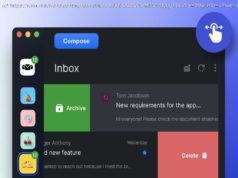This reMarkable 2 dupe runs Android and third-party apps
Onyx Boox Go 10.3 Monochrome: one-minute review
Onyx has been aggressively pushing out new ereaders and e-paper writing tablets for a while now – the brand released the unique and compact Onyx Boox Palma and the Boox Note Air 3 series in quick succession, then followed it up with a new series called Go. This includes the Onyx Boox Go Color 7 ereader and the Boox Go 10.3 writing tablet that launched together, and a smaller Go 6 ereader that came later. It’s nice to have choices but, at the speed that it’s churning out new models, is Onyx making great products to keep up with the competition?
With the Boox Go 10.3, the Chinese brand has done better than what it did with the Go Color 7, which had too many software flaws when I tested it. The Go 10.3, on the other hand, is a far better device that looks remarkably like the reMarkable 2.
As the name suggests, it’s a 10.3-inch dedicated e-paper writing tablet and, like its Scandinavian counterpart, writes like a dream. Stylus input is fantastic with no lag whatsoever. With different pen and brush choices, plus different nib thicknesses, it will easily work as a digital sketch pad too.
While the reMarkable 2 was designed to remove distractions from the creative process, the Go 10.3 isn’t so discerning – you get full access to the Google Play Store on account of it running on a trimmed-down version of Android 12, plus there are a lot more features in the note-taking application than on a reMarkable. It’s important to note that not all third-party apps will allow stylus input, so you’ll need to decide which ones will be the most useful to you.
It can also double up as an ereader thanks to the baked-in library app (NeoReader), something the reMarkable doesn’t quite master. However, lacking a screen light – just like the reMarkable – you’re not going to be able to use it for nighttime reading.
What I find most impressive here is that Onyx has trimmed its user interface down to make it a lot – and I do mean A LOT – more streamlined than on its previous e-ink tablets, but it still requires a slight learning curve. If you’re willing to put that time in, it could well be the better e-paper writing tablet for you, especially since the price difference between it and the reMarkable 2 isn’t all that different.Onyx Boox Go 10.3 review: price & availability
List price: $379.99 / €419.99 (about £355) / AU$699
Ships with a stylus and magnetic sleep case from the Boox Shop
Available to buy directly from the Boox Shop or third-party retailers
Launched in June 2024, the Boox Go 10.3 e-paper tablet carries a list price of $379.99 / €419.99 (about £355) / AU$699. When purchased directly from the Boox Shop, this price includes the stylus and a beige magnetic sleep case, but the latter may not be available as part of the bundle in some markets when bought from third-party resellers.
Given the reMarkable 2 has a similar price tag, now available for $379 / £389 / AU$639 bundled with the base Marker – which is a small drop since the reMarkable Paper Pro was launched – the Boox is quite well priced. In fact, it’s cheaper than the company’s own Onyx Boox Note Air 3, which retails for $479 / €549.99 (around £445) / AU$749 at full price.
However, without a screen light, it’s a little hard to recommend over other writing e-paper tablets like the Kobo Elipsa 2E ($399 / £350 / AU$629) and the Amazon Kindle Scribe (starting price of $339 / £339 / AU$549). If you want something far more portable than the 10-inch tablets, the Kobo Libra Colour will set you back $219.99 / £219.99 / AU$359.95 plus an additional $69.99 / £69.95 / AU$119.95 for the Kobo Stylus 2 purchased separately – that’s good bang for buck considering you get a good color display and the full suite of Kobo writing features.
• Value score: 3.5 / 5Onyx Boox Go 10.3 review: specsOnyx Boox Go 10.3 review: Design & display
Beautiful, slimline design in white and grey
10.3-inch E Ink Carta 1200 screen with no frontlighting
Built-in speakers and mic
The Boox Go 10.3 takes a lot of its design cues from the reMarkable 2 but there are some differences that make the Onyx tablet smaller, lighter and potentially more durable. For starters, the Go 10.3 has a textured rear panel that feels very much like faux leather but is plastic. It offers a lot more grip than the glass on reMarkable 2, and makes the Boox lighter in comparison. This also means that the Go 10.3 doesn’t need the little nubs that the reMarkable uses as feet to protect its rear panel.
The aluminum edges of the Go 10.3 are rounded, leading to slim bezels that sit flush with the glass screen. The lower bezel, which is broader on both the Boox and the reMarkable, is comparatively smaller on the Go 10.3, making it the slightly shorter tablet and potentially shaves off a tiny weight too. The flip side to that is the Go 10.3 is more prone to accidental screen touches as compared to the reMarkable 2. Personally, I prefer the bezels on the reMarkable 2, with the metallic finish and white borders – epitomizing Scandinavian minimalism – compared to the light grey on the Boox.
Keeping the rest of the design looking sleek, the Go 10.3’s power button, placed on the top right edge (compared to the top left on the reMarkable), sticks out only marginally, so you can find it by feel. The bottom edge houses the USB-C port in the middle, with speaker and mic grills on either side of it.
The Go 10.3 is now arguably the thinnest writing tablet in this class – its thickness is only just enough to enclose the aforementioned USB-C port – measuring just 4.6mm. That’s just a millimeter less than the reMarkable 2 which, until now, has held the title of the thinnest e-paper writing tablet. The Go 10.3 tips the scales at a mere 375g, which is lighter than the reMarkable 2 (403.5g) and the 2022 Amazon Kindle Scribe (433g). Despite that, it doesn’t feel fragile in the hand.
As the name suggests, the Boox boasts a 10.3-inch display, which uses the E Ink Carta 1200 screen technology. That’s now a generation behind with the Carta 1300 already in use in the Kobo Clara BW and Amazon adopting it in its 2024 range of Kindles. Where the Go 10.3 one-ups the reMarkable 2 is in screen resolution and overall contrast – you get a 300ppi display here (compared to 226ppi), while a side-by-side comparison shows that the blacks are blacker on the Boox. This makes text appear sharper on the Go 10.3 as compared to its competition, although the contrast on the Kobo Elipsa 2E (which also has a 227ppi screen resolution) is much better than the Go 10.3, which makes the latter a superior ereader.
That said, the reMarkable’s screen has a better anti-glare coating than the Boox – during my testing I frequently had issues with overhead lights creating bright spots on the Go 10.3, which made reading at certain angles quite difficult.
Thanks to the glass layer on the screen, writing on the Go 10.3 is a pleasure. I’d say it comes close to the reMarkable 2 and the Kindle Scribe – which are my favourite e-paper tablets to write on – with the Boox coming in a very close third. It ships with a stylus, which is a basic pen that doesn’t have the eraser functionality – for such a premium tablet, I think that’s a glaring omission.
If you’re buying the tablet directly from Onyx, you’ll also get a magnetic sleepcover for the Go 10.3. It’s a lovely-looking beige faux-leather folio, with a fold on the rear panel to convert it into a stand. However, the flap that keeps the folio closed is a separate piece that attaches magnetically and is easily dislodged when taking the tablet in and out of the bag. In fact, if you fold the cover back completely, the flap magnetically sticks to the front panel and comes away with it when you close the folio. It’s a small thing but I found it so annoying that I stopped using it after a couple of days into my testing.
Unfortunately you’re likely to lose the stylus without the folio case. While the right edge of the Go 10.3 is magnetic to secure the stylus, it’s too darn weak to be of any use. The curved edge doesn’t help either, reducing the amount of surface area the pen gets to secure itself to.
• Design & display score: 4 / 5Onyx Boox Go 10.3 review: Software & user interface
As mentioned earlier in this review, the Boox Go 10.3 runs a custom, trimmed-down version of Android 12 that focuses purely on reading and writing. Importantly, Onyx has also used this focus to streamline the user interface on the Go 10.3, which makes it a much easier Boox tablet to use than any I’ve tested before.
I suspect it’s this better UX that has eliminated a lot of the software issues I had with the Onyx Boox Go Color 7, or the company put all its efforts into the bigger flagship tablet and didn’t test out the smaller ereader enough before release.
Домой
United States
USA — software Onyx Boox Go 10.3 review: a versatile alternative to the reMarkable 2






